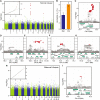A Prospective Analysis of Genetic Variants Associated with Human Lifespan
- PMID: 31484785
- PMCID: PMC6723124
- DOI: 10.1534/g3.119.400448
A Prospective Analysis of Genetic Variants Associated with Human Lifespan
Abstract
We present a massive investigation into the genetic basis of human lifespan. Beginning with a genome-wide association (GWA) study using a de-identified snapshot of the unique AncestryDNA database - more than 300,000 genotyped individuals linked to pedigrees of over 400,000,000 people - we mapped six genome-wide significant loci associated with parental lifespan. We compared these results to a GWA analysis of the traditional lifespan proxy trait, age, and found only one locus, APOE, to be associated with both age and lifespan. By combining the AncestryDNA results with those of an independent UK Biobank dataset, we conducted a meta-analysis of more than 650,000 individuals and identified fifteen parental lifespan-associated loci. Beyond just those significant loci, our genome-wide set of polymorphisms accounts for up to 8% of the variance in human lifespan; this value represents a large fraction of the heritability estimated from phenotypic correlations between relatives.
Keywords: GWAS; human; lifespan.
Copyright © 2019 Wright et al.
Figures






Similar articles
-
Variants near CHRNA3/5 and APOE have age- and sex-related effects on human lifespan.Nat Commun. 2016 Mar 31;7:11174. doi: 10.1038/ncomms11174. Nat Commun. 2016. PMID: 27029810 Free PMC article.
-
GWAS of longevity in CHARGE consortium confirms APOE and FOXO3 candidacy.J Gerontol A Biol Sci Med Sci. 2015 Jan;70(1):110-8. doi: 10.1093/gerona/glu166. Epub 2014 Sep 8. J Gerontol A Biol Sci Med Sci. 2015. PMID: 25199915 Free PMC article.
-
Family-based association analyses of imputed genotypes reveal genome-wide significant association of Alzheimer's disease with OSBPL6, PTPRG, and PDCL3.Mol Psychiatry. 2016 Nov;21(11):1608-1612. doi: 10.1038/mp.2015.218. Epub 2016 Feb 2. Mol Psychiatry. 2016. PMID: 26830138 Free PMC article.
-
Genetic factors associated with longevity: a review of recent findings.Ageing Res Rev. 2015 Jan;19:1-7. doi: 10.1016/j.arr.2014.10.005. Epub 2014 Nov 5. Ageing Res Rev. 2015. PMID: 25446805 Review.
-
Phenome and genome based studies into human ageing and longevity: An overview.Biochim Biophys Acta Mol Basis Dis. 2018 Sep;1864(9 Pt A):2742-2751. doi: 10.1016/j.bbadis.2017.09.017. Epub 2017 Sep 22. Biochim Biophys Acta Mol Basis Dis. 2018. PMID: 28951210 Review.
Cited by
-
A genome-wide association study of the frailty index highlights brain pathways in ageing.Aging Cell. 2021 Sep;20(9):e13459. doi: 10.1111/acel.13459. Epub 2021 Aug 25. Aging Cell. 2021. PMID: 34431594 Free PMC article.
-
Utilizing multimodal approach to identify candidate pathways and biomarkers and predicting frailty syndrome in individuals from UK Biobank.Geroscience. 2024 Feb;46(1):1211-1228. doi: 10.1007/s11357-023-00874-7. Epub 2023 Jul 31. Geroscience. 2024. PMID: 37523034 Free PMC article.
-
Geroscience in heart failure: the search for therapeutic targets in the shared pathobiology of human aging and heart failure.J Cardiovasc Aging. 2025;5(1):10.20517/jca.2024.15. doi: 10.20517/jca.2024.15. Epub 2025 Jan 14. J Cardiovasc Aging. 2025. PMID: 40297496 Free PMC article.
-
The accelerated aging phenotype: The role of race and social determinants of health on aging.Ageing Res Rev. 2022 Jan;73:101536. doi: 10.1016/j.arr.2021.101536. Epub 2021 Dec 6. Ageing Res Rev. 2022. PMID: 34883202 Free PMC article. Review.
-
Principal Component Analyses (PCA)-based findings in population genetic studies are highly biased and must be reevaluated.Sci Rep. 2022 Aug 29;12(1):14683. doi: 10.1038/s41598-022-14395-4. Sci Rep. 2022. PMID: 36038559 Free PMC article.
References
-
- Ball C., Barber M., Byrnes J., Callaway J., Chahine K. et al. , 2013. Ethnicity Estimate White Paper. https://www.ancestry.com/dna/resource/whitePaper/AncestryDNA-Ethnicity-W....
-
- Ball C., Barber M., Byrnes J., Carbonetto P., Chahine K. et al. , 2016. Ancestry DNA Matching White Paper. https://www.ancestry.com/corporate/sites/default/files/AncestryDNA-Match....
Publication types
MeSH terms
Substances
LinkOut - more resources
Full Text Sources
Miscellaneous
